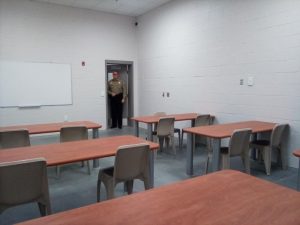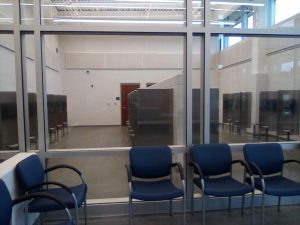
Henry County Sheriff Lane Perry said the new Henry County Adult Detention Center provides more services to inmates while remediating many of the issues associated with the former jail. And now more than ever, inmates find the help and support they need to beat the issues that led to their incarceration.
Like corrections officers and some inmates, Perry recalled the conditions in the former jail, which was originally built to house 67 inmates.
It was expanded in the mid-90s to contain 126 beds, but the size of the building did not change, officials have said.
“There was a time where we got up to about 215 inmates inside a place that was originally designed for 67,” the sheriff said, adding that the new detention center was built out of necessity.
County officials have said the former jail will be demolished after all of the equipment it houses is repurposed, refurbished and/or sold at auction.
In addition to the conditions in the outdated facility, overpopulation in the old jail led to a number of problems, including fights and trying to find ways to separate inmates who could not get along with each other, according to Perry and previous reports.
“We really had a problem with, we call them the ‘keep-aways.’ This inmate can’t get along with this inmate, and so we were having fights inside the cells. Now, we can spread them out,” Perry said.
The new detention center includes multiple wings. It is divided into minimum, medium, and maximum security.
“The ones that run the most risk, either by the violence they’ve committed or the risk to the officers or to the other inmates,” are housed in the maximum security wing, Perry said. “If they’re bound and determined they’re going to” cause problems, “they wind up back there and have very little movement” or freedom in the center.
The majority of inmates, however, are housed in the minimum or medium security wings.

“Most of them, you can house all together and give them a lot of freedoms,” Perry said. “They can move around, they aren’t in the small cells, they can sit at the table and play cards if they want to.”
The process for building the new detention center, which can house up to 400 inmates, began in 2015 with a Community-based Corrections Plan, Perry said.
“That’s where they took all of our data and the increase in inmates, and they put a plan together. Because the state is paying for 25 percent of this building,” Perry said.
The state looked at the projected growth in inmate population to arrive at the 400 bed facility, he said. The county was then tasked with finalizing plans for a new center, touring other detention centers to get design ideas.
The total cost of the detention center was $78 million, with the county responsible for $51 million, and the state funding the remainder.
Currently, 249 inmates are housed in the facility. Inmates began moving into the new center on March 25.
The detention center offers a wide variety of programs and services to inmates housed there, Perry said, with upgraded services and technology, health care and even continuing education classes available to most of the center’s current inmates.
Currently, there are two classrooms in the detention center that can be used for educational services, such as allowing inmates to work towards their GED.
“We are just starting the GED program,” Perry said. “A lot of young people, they didn’t have good environments they were raised in. There are a number of young people, they never had a mom or dad structure, anything like that. They didn’t have anybody to help keep them focused with education and stuff, and there’s a part of that that’s not their fault.
“But when they get inside here and get settled down, we actually have people that come in that work with them on their GED, and we’re also trying to line up some things that may even get to some college related classes,” Perry said.
iPads are used for a wide variety of services such as mail, education, and more.
“The iPad technology is another thing that we have. We don’t have an iPad for every inmate, they wind up sharing them,” Perry said. “There are multiple parts to that. One, we do a lot of training through that. They can take the training. They can take anger management, substance abuse. They can take educational classes, work on their GED, work on training skills and things.”
Inmates also can study the academic parts of trades, such as welding. The iPads are also how the inmates receive their mail, which cut down on the issue of drugs being smuggled into the facility. That was an ongoing issue in the former facility, he said.
“We do not have mail that comes into this place anymore. We were having problems,” with “soaking the paper in suboxone, fentanyl, things like that. The inmates would rip it up and chew it if they knew it was on there. So, all of their mail goes to a place outside of Virginia,” Perry said.
There, the mail “is scanned and they are sent an email. They can read it, but they do not have paper. It really cut down on the risk to the facility,” Perry said.
There also are TV screens in the center that are capable of offering a multitude of services, many of which are in the works.
“We can actually do hearings with the court. It’s called group counseling, we can do individual counseling, and then we can also do most tele-psychiatry. We can do some tele-med, but most of that needs to be done in person,” Perry said.
There is also a mental health wing for inmates battling severe mental illnesses, such as bipolar disorder and schizophrenia. Inmates receive services from Piedmont Community Services.
“When people fight mental illnesses, they sometimes have little quirks and habits that agitate other people, who are just mean,” and often pick on those having issues, Perry said.
“It’s constantly a problem,” Peery said. “Now, we can separate the” inmates into a more controlled population. “Most of the people they will be around, they all know they’re fighting something.”
Also new is a well-equipped medical wing now handles all but the more serious medical problems.
“We only have to take people out if there’s a serious medical problem. We have Wellpath, which provides medical services here,” Perry said, and added nurses are staffed “around the clock.”
During the day, the company provides “a physician’s assistant or a nurse practitioner, and then they also have a doctor that comes through at various times,” Perry said. “If you need someone who needs specialized care, you actually have staff right there. It’s not a hospital, but it’s pretty close to it to an extent.”
Staff in the center are always working on more services that can be added to help rehabilitate inmates, such as a law library.
“A lot of the inmates, when you get them in, when you get the drugs and alcohol out of their system, they aren’t bad people,” Perry said. “They just have an addiction” or some other issue “that they’re trying to fight.”




